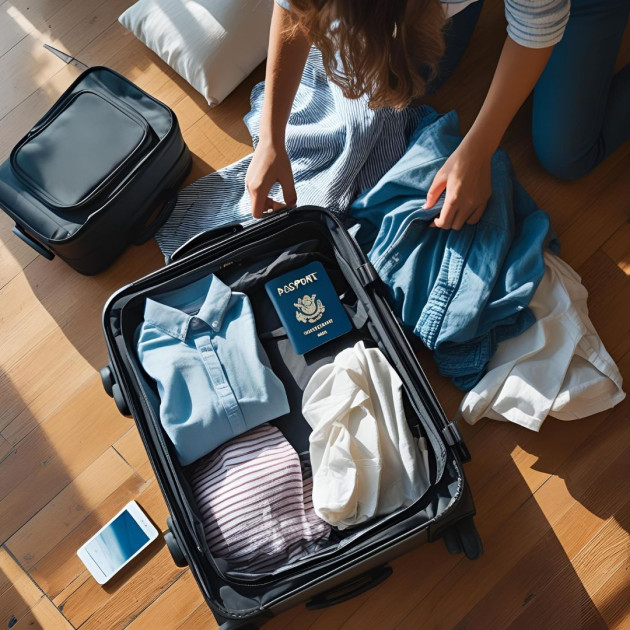Ultimate South America Packing Guide

South America is a continent of contrasts: lush Amazon rainforests, snow-capped Andes peaks, sprawling deserts, and idyllic beaches. From the colonial streets of Cusco, Peru to the Patagonia wilderness of Argentina and Chile, your adventures will take you across vastly different climates and terrains. This makes packing strategically not just smart, but essential for comfort, safety, and enjoyment. Competitours has curated the ultimate packing guide to ensure you’re prepared for every adventure, no matter where your journey takes you.
Whether you’re hiking in the Andes, exploring Machu Picchu, or enjoying the beaches of Rio de Janeiro, these 40 essential items will help you travel light, stay organized, and fully embrace the adventure. Brought to you by Competitours, the number one mystery vacation company in the world!
South America Travel Essentials
Your journey begins before you leave home. Travel essentials ensure you’re legally prepared, organized, and ready for any situation:
- Passport (valid at least 6 months beyond your trip)
- Visa documentation (if required for countries like Brazil or Argentina)
- Printed itinerary and confirmations
- U.S. Department of State international travel checklist – travel.state.gov
- Health insurance card and info
- Emergency contacts list
- Copies of passport & vital documents (stored separately)
Clothing & Footwear (Layering Is Key!)
South America’s climates vary dramatically. Layering is essential for comfort, whether you’re hiking chilly mountain trails in Bolivia or exploring sunny coastal cities in Uruguay. Versatile clothing allows you to adapt without overpacking:
- Lightweight base layers (T-shirts, tees)
- Long-sleeve shirts for sun protection or cooler evenings
- Fleece or sweater for warmth in high-altitude regions like La Paz, Bolivia
- Waterproof jacket for rainforests like the Amazon in Brazil or Peru
- Quick-dry hiking pants
- Comfortable jeans or casual pants
- Shorts or lightweight skirt for tropical destinations like Cartagena, Colombia
- Compact scarf or buff (for warmth, cultural modesty, or dust protection)
- Wide-brim hat or cap for sun protection
- Underwear and breathable socks (moisture-wicking recommended)
- Sturdy walking or hiking shoes
- Lightweight sandals for casual wear or hostel showers
Health & Safety
Your health and safety are critical when traveling across diverse environments. From high-altitude areas to tropical regions, proper preparation minimizes risks:
- Prescription medications with doctor’s note
- Basic first aid kit
- Altitude sickness medicine (for destinations like Cusco or La Paz)
- Hand sanitizer or wipes
- Insect repellent (CDC recommends for Amazon regions)
- Sunscreen (SPF 30+) and lip balm with SPF
- Water purification tablets (for remote areas or river excursions)
- Sunglasses with UV protection
Electronics & Accessories
Tech gear and organizational tools make your travel smoother and help capture memories:
- Universal power adapter
- Phone + charger
- Portable power bank
- Camera or smartphone with enough storage
- Packing cubes to organize gear efficiently – en.wikipedia.org
- Reusable water bottle (BPA-free or stainless steel)
Miscellaneous but Essential Items for Traveling in South America
These items may seem minor, but they make a huge difference in comfort and convenience during your travels:
- Lightweight daypack or foldable backpack (for daily excursions)
- Travel towel (quick-dry, compact)
- Compact umbrella or light rain poncho
- Laundry detergent sheets or sink plug
- Money belt or RFID-blocking wallet
- Travel journal and pen
- Mini sewing kit or repair tape
4 Tips for South American Travel Documents & Security
Having your documentation organized is crucial, especially when traveling to multiple countries with varying entry requirements. South American countries often have different visa rules, and border control can be strict.
- Check the U.S. Department of State travel advisories for each country – travel.state.gov
- Review U.S. Customs and Border Protection travel resources – cbp.gov
- Carry physical and digital copies of passports, tickets, and important reservations
- Keep emergency contact numbers for local embassies and family at home
Country-Specific Packing Tips
South America’s diverse climates mean some items are essential in certain countries:
- Peru: Warm layers for Machu Picchu and Cusco; rain jacket for sudden showers; altitude sickness medication.
- Brazil: Lightweight tropical clothing for Rio and the Amazon; insect repellent for jungle excursions.
- Chile & Argentina: Warm clothes and waterproof hiking shoes for Patagonia; sunscreen and sunglasses for high-altitude hiking.
- Colombia: Comfortable casual clothing for city exploration; light jacket for cooler mountain regions like Medellín.
- Uruguay: Beachwear for coastal towns; windbreaker for breezy Montevideo evenings.
Our TLDR Recommendations for 2025:
Packing efficiently ensures you’re ready for all adventures South America offers without overloading your luggage. Remember to layer clothing for variable climates, carry essential health and safety items, and keep important travel documents organized. Using packing cubes, a daypack, and a reusable water bottle will make your daily excursions more convenient and enjoyable.
For additional packing tips and organization advice from university study abroad programs, see Iowa State University’s guide: studyabroad.iastate.edu.
By following this Ultimate Packing Guide, you’ll be prepared for jungle treks, mountain hikes, city explorations, and beach relaxations across South America.
🌎 The Ultimate FAQ for Packing for South America
1. What are the climate differences across South America?
South America boasts diverse climates due to its vast geography. Here's a breakdown by country:
- Peru (Cusco): High-altitude regions like Cusco experience cooler temperatures, ranging from 55°F (13°C) to 75°F (24°C) in August. Evenings can be chilly, so layering is essential.
- Brazil (Rio de Janeiro): Coastal cities like Rio enjoy tropical climates with temperatures between 63°F (17°C) and 76°F (24°C) in August. Light clothing is suitable, but a light jacket may be needed for cooler evenings.
- Chile (Santiago): In August, Santiago experiences mild temperatures from 42°F (6°C) to 77°F (25°C), with a mix of sun and occasional showers.
- Colombia (Bogotá): Bogotá's high-altitude location results in cooler temperatures averaging 47°F (8°C) to 69°F (20°C) in August. Rain is common; waterproof gear is recommended.
- Uruguay (Montevideo): Cooler temperatures in August, ranging from 40°F (5°C) to 58°F (15°C), with low clouds and occasional sun.
2. How safe is it to travel in South America?
Safety varies across regions:
- Chile & Uruguay: Among the safest countries in South America, offering stable environments for travelers. WorldPopulationReview
- Argentina & Colombia: Popular tourist destinations, though certain urban areas have higher crime rates. Stay informed and exercise caution, especially in cities.
- Peru: Reports indicate higher organized crime in Lima and parts of the Amazon basin. Avoid isolated areas after dark. The Sun
3. What are the visa requirements for U.S. travelers?
- Brazil: U.S. citizens do not require a visa for stays up to 90 days.
- Argentina: Visa-free for tourism up to 90 days.
- Chile: No visa required for stays under 90 days.
- Colombia: Visa-free for up to 90 days.
- Peru: No visa needed for up to 183 days.
Always check the latest requirements before traveling, as policies may change.
4. What are some must-visit destinations in South America?
- Machu Picchu, Peru: UNESCO World Heritage site. More info
- Patagonia, Argentina & Chile: Dramatic landscapes with glaciers, mountains, and unique wildlife.
- Galápagos Islands, Ecuador: Unique ecosystems with wildlife found nowhere else.
- Rio de Janeiro, Brazil: Famous for beaches, culture, and the Christ the Redeemer statue.
- Salar de Uyuni, Bolivia: The world's largest salt flat, ideal for photography.
5. What is the average cost of traveling in South America?
- Budget Travelers: $30–$50 per day, including accommodations, meals, and local transportation.
- Mid-Range Travelers: $50–$100 per day, allowing comfortable lodging and occasional guided tours.
- Luxury Travelers: $100+ per day, including high-end hotels, fine dining, and private tours.
- South America offers options for all budgets. IndieTraveller
6. What vaccinations are recommended before traveling?
This is not formal legal or medical advice. This is meant to be researched individually and consult your doctor or lawyer for all travel tips.
- Hepatitis A & B: Recommended for most travelers.
- Typhoid: Especially if visiting rural areas or consuming local food/water.
- Yellow Fever: Required for certain regions, like the Amazon basin.
- Malaria Prophylaxis: For areas with malaria risk.
- Routine Vaccinations: Ensure MMR, Tdap, and influenza vaccines are up-to-date.
7. What languages are spoken across South America?
- Spanish: Most countries, including Argentina, Chile, Colombia, Peru.
- Portuguese: Brazil.
- Quechua & Aymara: Indigenous languages in Peru, Bolivia, Ecuador.
- Guaraní: Official language in Paraguay.
- English is limited outside major tourist areas.
8. What are the transportation options between countries?
- Flights: Major cities like Buenos Aires, Lima, Santiago are well-connected.
- Buses: Economical, popular for neighboring countries.
- Trains: Limited but scenic routes like the Andean Explorer in Peru.
- Private Tours: Offer convenience and local insights.
9. What are some cultural considerations to keep in mind?
- Punctuality: Valued in Chile and Argentina, especially in business.
- Greetings: Handshakes in professional settings; cheek kisses among friends in Argentina.
- Dress Code: Modesty in religious sites; upscale venues may require formal attire.
- Tipping: Restaurants 10–15%; guides and drivers customary.
10. How can I stay connected while traveling?
- SIM Cards: Claro, Movistar, Tigo; available at airports and shops.
- Wi-Fi: Hotels, cafes, public spaces; remote areas may have limited connectivity.
- VPN: Recommended for secure browsing and region-locked content.


